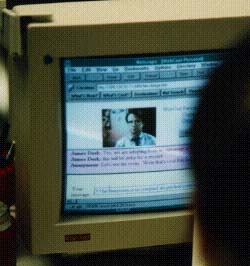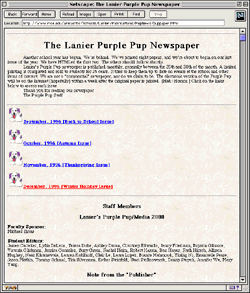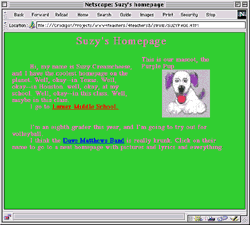



Interested in writing a story
or nominating a friend? Yes
Translate this story into Spanish? Yes
|
Technology: Time-saver or time-waster?
A technology teacher echoes B.F. Skinner, who stated in 1969 that, "the real problem is not whether machines think but whether [people] do."1 by Michael Sirois |
|
This question continues to plague me, and has since I started teaching this course. A few years ago, I was teaching Creative Writing/Journalism when our grant to teach an experimental business course was approved. By the beginning of the 1994-95 school year, we had equipment on order and a new course name, Media 2000. I don't know how they came up with that name, but, since we do delve into several different types of communication media, the name works, at least for a few more years. |
 Is this student surfing fun sites or working? |
We operate as if we are a business--a publishing house. We work on both online and paper products, and we meet every other day for 90 minutes each session. The class publishes the school's newspaper and literary magazine and maintains the school's Web site. Each issue of the monthly newspaper is first printed for sale to students at the school, then marked up with HTML for publication on the Web. Every student in the class is required to write an article for each paper. The articles go through a peer review process by the student editors, students who, after applying for the positions, demonstrate a willingness and an ability to work well with words and computer code and people (well, okay--that's the perfect editor). Editors are also assigned a few students to work with individually, to help carry them through the process of article writing or writing HTML code. |
|
|
 The electronic version of the Lanier red Pup Newspaper. |
"The deadline for the first draft of the October issue of the paper is next Monday. So, today you need to concentrate on two things. First, make sure you've completed all the preliminary work on your October article before next Monday. Have it in good enough shape that someone can look at it and make decisions about possibly using it in the next issue. Today is Tuesday, so that means you'll have today and Thursday to work on them before we take them up. Second, with any time you have left, work on your Web pages, making sure you include some of your information in a table, and some in a list." As soon as most of the students are busy, I put some of my student editors to work. Some are going to create posters to advertise newspaper subscriptions, and some are going to fix the HTML for the PTA's weekly newsletter, which we post on the Web. We're behind on the newsletter, and I make sure they know it has top priority before I begin monitoring the other students. |
|
One student is experimenting with different color backgrounds and text combinations. "Suzy's Homepage" displayed in bright pink on a lime red background is definitely not the right combination, so she holds down the Alt-Tab keys and shifts back to her word processor. After a little tinkering, a milder red and a dark-brown mix seems to work. On the other side of the room, a picture of Tupac Shakur appears on Bartley's monitor, and--just down the row from him--Angela is looking at the same Mariah Carey page she was visiting the last time the class met, and the time before that, and the time before that. After a little intervention, they are back on track--for the time being. |
|
Another student wants to know why the background image they've chosen isn't displaying on their homepage. I watch them check the Document Source in the View Menu of Netscape. Some of the code is blinking at us. Something is broken. He spots it--a tag wasn't closed off. He closes Netscape, opens Notepad, opens his document, fixes the code, saves his file, closes Notepad, opens Netscape, points the browser to his file, and sees that the background still isn't displaying. Apparently, he didn't get the Alt-Tab shortcut when I explained it the other day. I show him that he doesn't have to keep opening and closing documents. He tries it, and sees how much easier that is, but a minute later he's saving his work and closing Notepad. |
|
Several students in this class seem to be working on their articles as much or more than their Web pages. Perhaps I emphasized it a little more strongly at the beginning of this period, or maybe it's just the nature of this particular class. |
|
|
|
First I stop and talk to those who seem to be just staring. The answers are fairly typical for a first day of writing. Some students get that glazed-over look when they find out they're going to have to write something. Their typical response is something like, "I just can't think of anything to write." I encourage them to not listen to that little voice in their head that's telling them that, and show them some brainstorming techniques and work with them for a few minutes. Next I check in with the scribblers, to make sure the writing is about their articles. I find one which begins, "Hey, Chica, wuz up . . ." (actually "wuz" followed by an upward-pointing arrow), so I keep it and get Linda thinking about the next newspaper, then I start wandering through the room. |
 The color combination that Suzy rejected. |
A few are inappropriate, like Jimmy's, which begins, "I think that the school dress-code sucks bigtime, and so do lots of others. I asked 100 seventh graders what they thought and this is what they thought." "Sucks," said Ron Darwin. "Sucks, said Kavonna Smith. It went on from there. You get the drift. Maria's began, "One of the most terrible things that we in the world have to face today is the environment," and continues with a quote about global warming, which she correctly attributed to an encyclopedia, but which goes on for three paragraphs. I take a few minutes to explain to Jimmy why his article won't work. Essentially, it's too personal, uses inappropriate language, and was already covered in our first issue of the year. I let Maria know that the idea of her article is fine, but that the words need to be at least 90 percent hers. |
|
Some are very carefully tapping on the space bar to line up their titles in the center of the 80-character wide monitor. I have to explain to them (again) that the newspaper is divided into columns that are only about 35 characters wide. If they shape their words to fit the monitor, it will be all wrong for the publication. Some are also tapping on the space bar when they finish a paragraph, to push their cursor to the next line. I have to use the same explanation to let them know what all that extra space is going to do when their article is placed into a column in PageMaker. A few others are hitting the return key at the end of each line instead of letting the words wrap by themselves. All are symptoms of the same disease--worrying more about the way the words look on a screen rather than worrying about what the words convey. Most of the students were using the Notepad text editor as they were encouraged to do, but Sam has discovered a copy of Lotus Ami Pro word processor on his computer, and is busily centering, bolding, changing type sizes and fonts. It looks pretty good, but would be totally useless for our purposes. I have him save it to his disk as plain text, and open it in Notepad. It looks like a pretty good article, but I noticed Sam working on it earlier while I was working with some other students. He spent about 30 minutes working on the article, and most of the rest of the period fiddling with fonts. How much more complete would his article have been if he had just concentrated on the words? |
|
I have more questions than answers, though. I wonder if the students will ever understand how much time they waste on various things. I wonder if they've figured out how insidious time can be, sneaking up on you and saying, "Surprise, there's no more of me left," at the most inopportune moments. The more I think about it, the more I realize I used to and sometimes still do exhibit some of the same traits. How often have I stopped what I was doing to fiddle with my computer's interface, adjust the look of Program Manager to get it organized just right, played just one more game of Solitaire, changed the fonts on a document five times to get exactly the right look? |
|
Endnote [1]. Skinner, B. F. (1969). Contingencies of reinforcement: A theoretical analysis. New York: Appleton Century Crofts. |
|